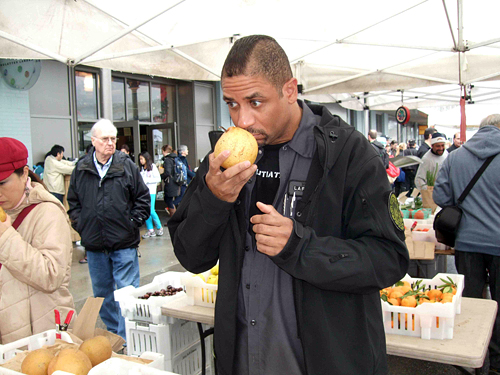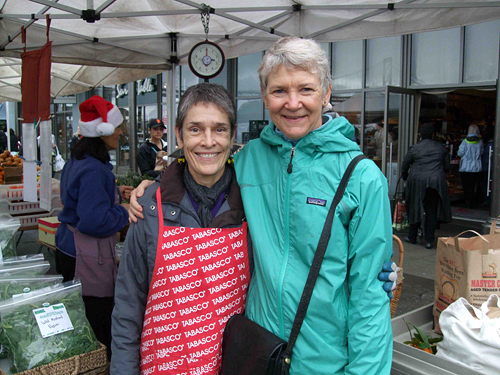We think of Annie Somerville, proprietor of the legendary vegetarian restaurant Greens, as a true goddess of produce here in the Bay Area, so we met her first. She suggested we convene at the Knoll Farms stand, a biodynamic farm from Brentwood where we'd see all kinds of chefs lurking throughout the morning.
Somerville was thrilled to see the beginnings of green garlic there ("I am so happy!" she exclaimed), something she says proprietor Rick Knoll actually pioneered and is typically found after the winter. When asked what to look for, she said,
"Look for it to look just like that! Just really fresh and nice, the point is that it is the young stalks, the shoots. As they get more mature, they get longer and at the end there they start to bulb up and [wilt] and at some point you probably want to let it go. We use the shoots for sautéing. All the applications of fresh garlic, use your green garlic instead. Put it in any dish. All the tops can go into soup stock."
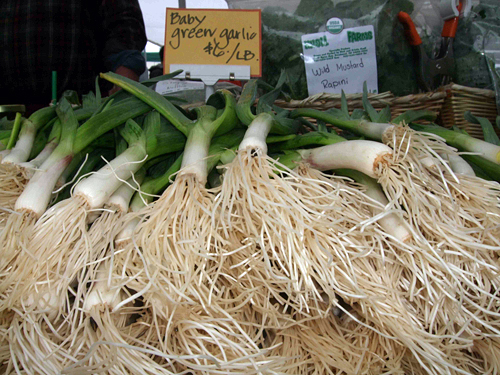
Green garlic
She finds it a wonderfully versatile ingredient, but seemed most excited about her plans to add it to mashed potatoes. One of Kristie Knoll's favorite preparations, meanwhile, is to cut the stalks into "knuckles" and brown them.
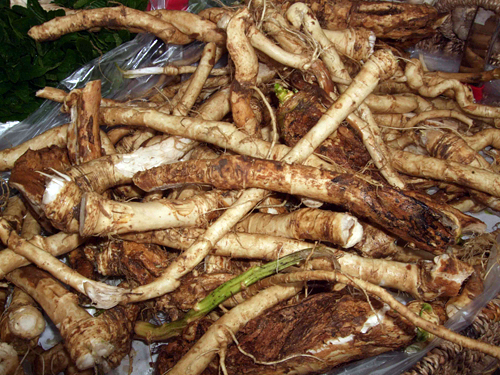
Horseradish root
While at the Knoll stand, we stumbled into Michael Tusk, chef/owner of Quince and Cotogna restaurants, selecting some horseradish. He says to look for pieces that aren't dried out. And, in this case of this root, size matters.
"I personally like the bigger pieces; they're easier to grate," he said. "We use it in a salad with smoked eel and with beef, but I usually I just find stuff and then I decide what to do. It's good to have inspiration around, especially at this time of year, so I try to find as many fun things as possible."
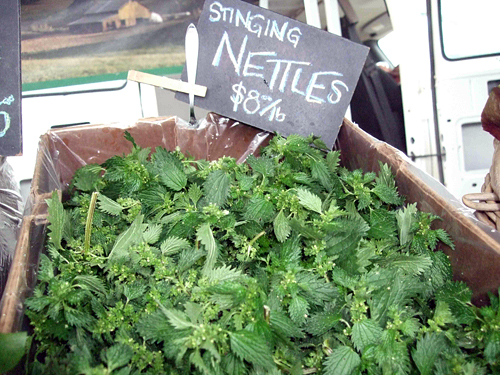
When we caught up with David Bazirgan, the new executive chef of Fifth Floor, he was hoisting up a giant bag of stinging nettles from Marin Roots Farm and explaining that he ingeniously uses them in place of spinach for a side dish of creamed nettles to accompany his new menu item, a dry aged New York steak also served with salt baked potatoes, roasted mushrooms, and red wine sauce. (He Thermo-mixes them so they don't sting.) Since this isn't an item eaten raw, picking them is a lot easier than other ingredients, but Bazirgan still suggests carefully looking through them for a vibrant, consistent color and no holes.
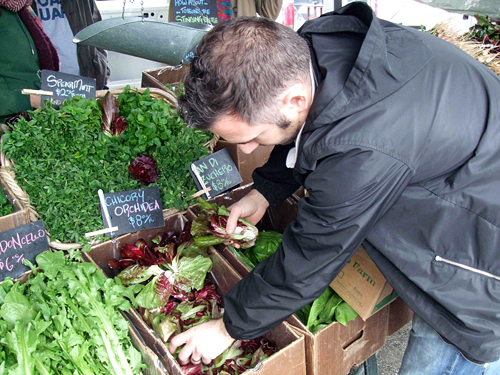
David Bazirgan of Fifth Floor selects chicories.
Bazirgan also uses color cues when picking various chicories at Marin Roots, selecting the most vibrant leaves; look for the whites as well as the colors to be bright. He is currently using various heirloom varieties of chicories in a salad, dressed raw with compressed persimmon, Pt. Reyes blue cheese, hazelnuts, pomegranate, vadouvan, and Chardonnay vinaigrette.
For Mark Richardson, the executive chef of Seasons Restaurant at Four Seasons Hotel San Francisco, Brussels sprouts are a winter produce staple.
"Look for the sprouts with tight-fitting leaves, with no browning or yellowing," he advised. "If you can find the sprouts still on the stalk, they will be the freshest."
His preparation for them is minimal: After blanching, he caramelizes the sprouts in a pan with some olive oil and then seasons with salt, fresh cracked pepper, and chili flakes. If you can't make it to Ferry Plaza, Richardson also suggests buying them at Mollie Stone's or Whole Foods locations.
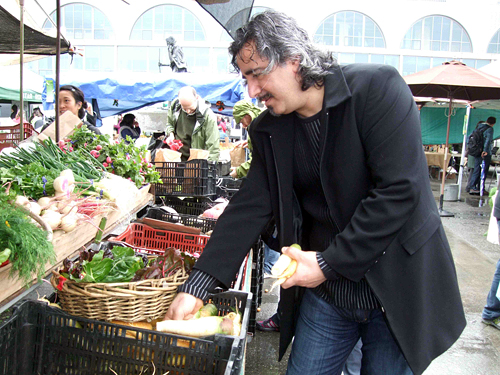
Hoss Zaré of Zaré at Fly Trap examines white carrots.
Hoss Zaré of Zaré at Fly Trap truly shocked us when we met him to scout out white carrots. We gravitated towards the biggest ones, but Zaré said that was actually not the best strategy.
"The bigger ones are woodier and less juicy," he cautions. "Too small, and they're not going to have much flavor. You have to get the medium-sized ones so you get a lot of juice and flavor. Big ones are good for braising -- chop them up and caramelize them, but the smaller ones are juicier."
His favorite current use for white carrots is to lightly peel, blanch, pan roast until lightly caramelized, and then stack with slices of braised lamb tongue.
As we were about to leave Ferry Plaza full of new ideas and new produce specimens to experiment on, we grabbed Russell Jackson, chef/owner of Lafitte, just steps up the Embarcadero from Ferry Plaza. He was checking out the produce at Hamada Farms, the Kingburg grower whose citrus and pears seem to be the secret weapon of the chefs who shop at Ferry Plaza.
"Which kind of pear do I want today?" he asked.
"Niitaka!" came the answer from two people behind the counter, in unison. Jackson leapt over to the box and started smelling.
"Surface indication really isn't anything," he said, pointing out some visible flaws on a Niitaka. "It's really about the texture, firmness, and I'm really looking for that aromatic quality to it. You don't want something heavily bruised, but [some flaws] are just from tree hang, or where it faces the sun, or whether it's been scratched by a branch."
Right now, he's roasting pears to make a demi-glace for roasted sweetbreads and also using them raw in a salad with persimmons, chicories or radicchio, walnuts and Banyuls vinaigrette.
